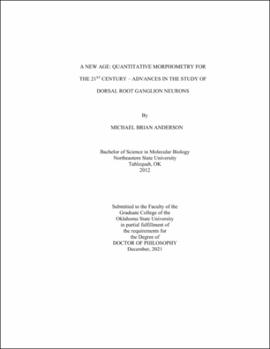| dc.contributor.advisor | Miller, Kenneth E. | |
| dc.contributor.author | Anderson, Michael Brian | |
| dc.date.accessioned | 2022-05-13T15:26:19Z | |
| dc.date.available | 2022-05-13T15:26:19Z | |
| dc.date.issued | 2021-12 | |
| dc.identifier.uri | https://hdl.handle.net/11244/335710 | |
| dc.description.abstract | Dorsal root ganglion (DRG) neurons transduce sensory information in peripheral tissues, transmitting centrally as action potential frequency, along second and third order neurons for processing in the somatosensory cortex. DRG neurons are the focus of study for researchers to understand pain pathways, and clinicians in the diagnosis of neuropathic disease. Adjuvant induced arthritis (AIA) is an inflammatory (arthritis) model used in pain research but apoptosis and neuronal integrity during the AIA model was unknown. Researchers study the cell body of DRG neurons to evaluate proteins and pathways involved in the maintenance of long-term pain and inflammation. Techniques for measuring the cell body of DRG neurons are accurate but take considerable time, reducing the scope of the experiment, and are susceptible to bias and error. In the diagnosis of several peripheral neuropathies, clinicians measure the cross-sectional density of protein gene product 9.5 (PGP9.5) immunoreactivity, a pan neuronal (antibody) biomarker reactive to intra-epidermal nerve fibers (IENFs); however, global two-dimensional (2D) densiometric measurement of branching three-dimensional (3D) IENFs lack resolution to evaluate individual IENFs. In these studies, I have evaluated neuronal integrity of DRG neurons at the peak time point of the AIA model and observed no apoptosis or loss of integrity. Automatic identification and segmentation of DRG neurons was achieved by developing an algorithm, in conjunction with the use of a biomarker for DRG neurons. Morphologic 3D quantitation of IENFs was achieved by epidermal isolation, tissue clearing, immunolabelling, and measurement/reconstruction, per IENF. High-throughput analysis of DRG neurons and morphometric analysis of individual IENFs opens the doors to the future of DRG neuronal analysis for both researchers and clinicians. To naturally observe, interact, and communicate 3D data, a novel use of the Unreal Engine was employed to develop an educational, and downloadable, experience. | |
| dc.format | application/pdf | |
| dc.language | en_US | |
| dc.rights | Copyright is held by the author who has granted the Oklahoma State University Library the non-exclusive right to share this material in its institutional repository. Contact Digital Library Services at lib-dls@okstate.edu or 405-744-9161 for the permission policy on the use, reproduction or distribution of this material. | |
| dc.title | New age: Quantitative morphometry for the 21st century - Advances in the study of dorsal root ganglion neurons | |
| dc.contributor.committeeMember | Wilson, Nedra | |
| dc.contributor.committeeMember | Koehler, Gerwald | |
| dc.contributor.committeeMember | Warren, Aric | |
| osu.filename | Anderson_okstate_0664D_17454.pdf | |
| osu.accesstype | Open Access | |
| dc.type.genre | Dissertation | |
| dc.type.material | Text | |
| dc.subject.keywords | acute inflammation | |
| dc.subject.keywords | calcitonin gene-related peptide | |
| dc.subject.keywords | dorsal root ganglion neurons | |
| dc.subject.keywords | image cytometry | |
| dc.subject.keywords | intra-epidermal nerve fibers | |
| dc.subject.keywords | volumetric imaging | |
| thesis.degree.discipline | Biomedical Sciences | |
| thesis.degree.grantor | Oklahoma State University | |
